Project Scheduling and Control for a New Personal Trainer Business
VerifiedAdded on 2023/03/20
|14
|3030
|42
Project
AI Summary
This project schedule outlines the steps for launching a personal trainer business in Australia, addressing the increasing demand for fitness professionals. The report details the project scheduling and control approaches used, including a Work Breakdown Structure (WBS) to break down the project into manageable tasks, a project network diagram for visual planning, and a Gantt chart for scheduling. The project incorporates budgeting, critical path and critical chain analysis to determine project duration, and Earned Value Management (EVM) to measure project performance. The report also explores Agile and Lean project management methodologies, project crashing techniques, and lists project deliverables. Recommendations for project success are provided, emphasizing the adoption of various project management techniques and key success factors to ensure the business launch within budget and on schedule.
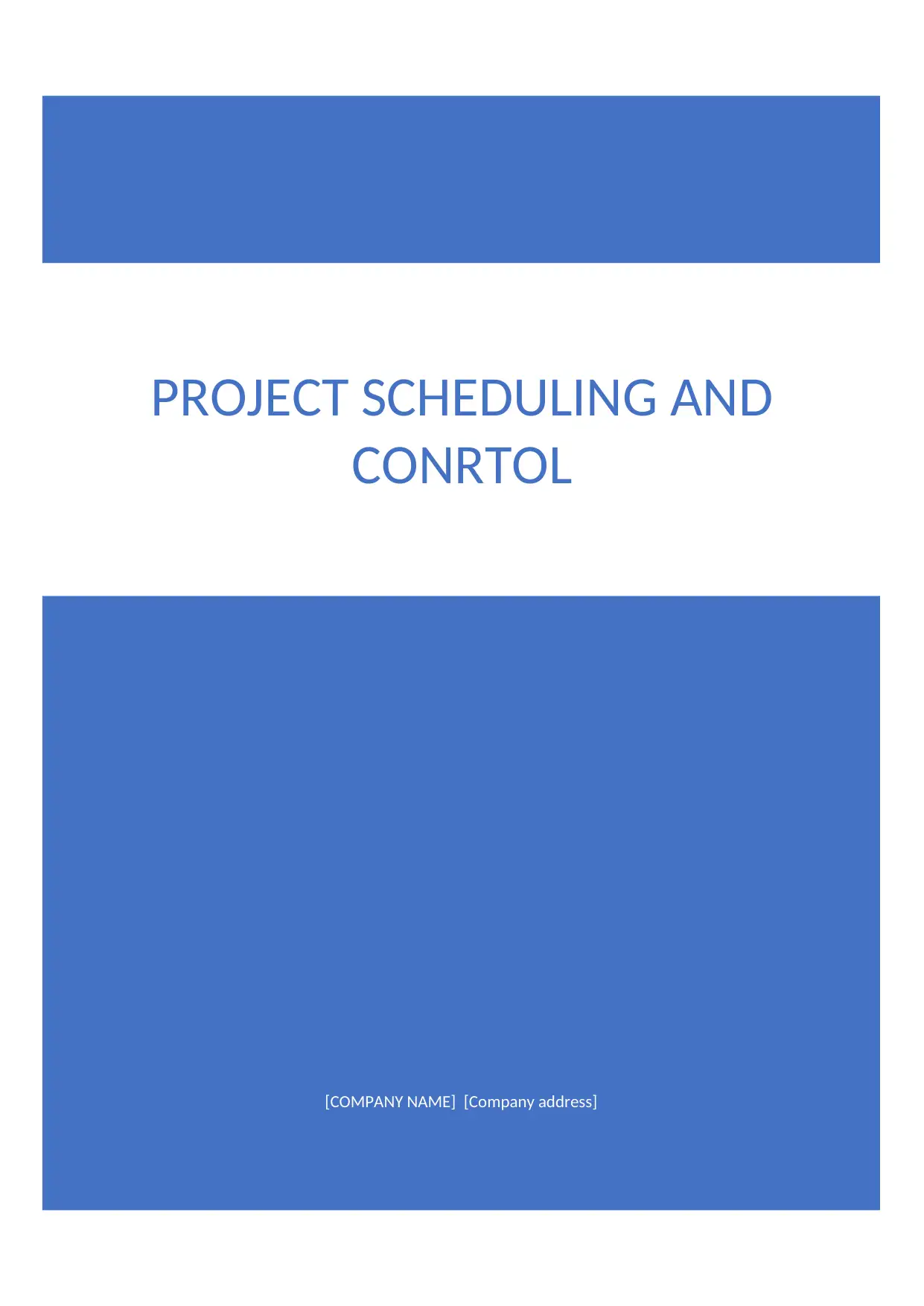
[COMPANY NAME] [Company address]
PROJECT SCHEDULING AND
CONRTOL
PROJECT SCHEDULING AND
CONRTOL
Paraphrase This Document
Need a fresh take? Get an instant paraphrase of this document with our AI Paraphraser
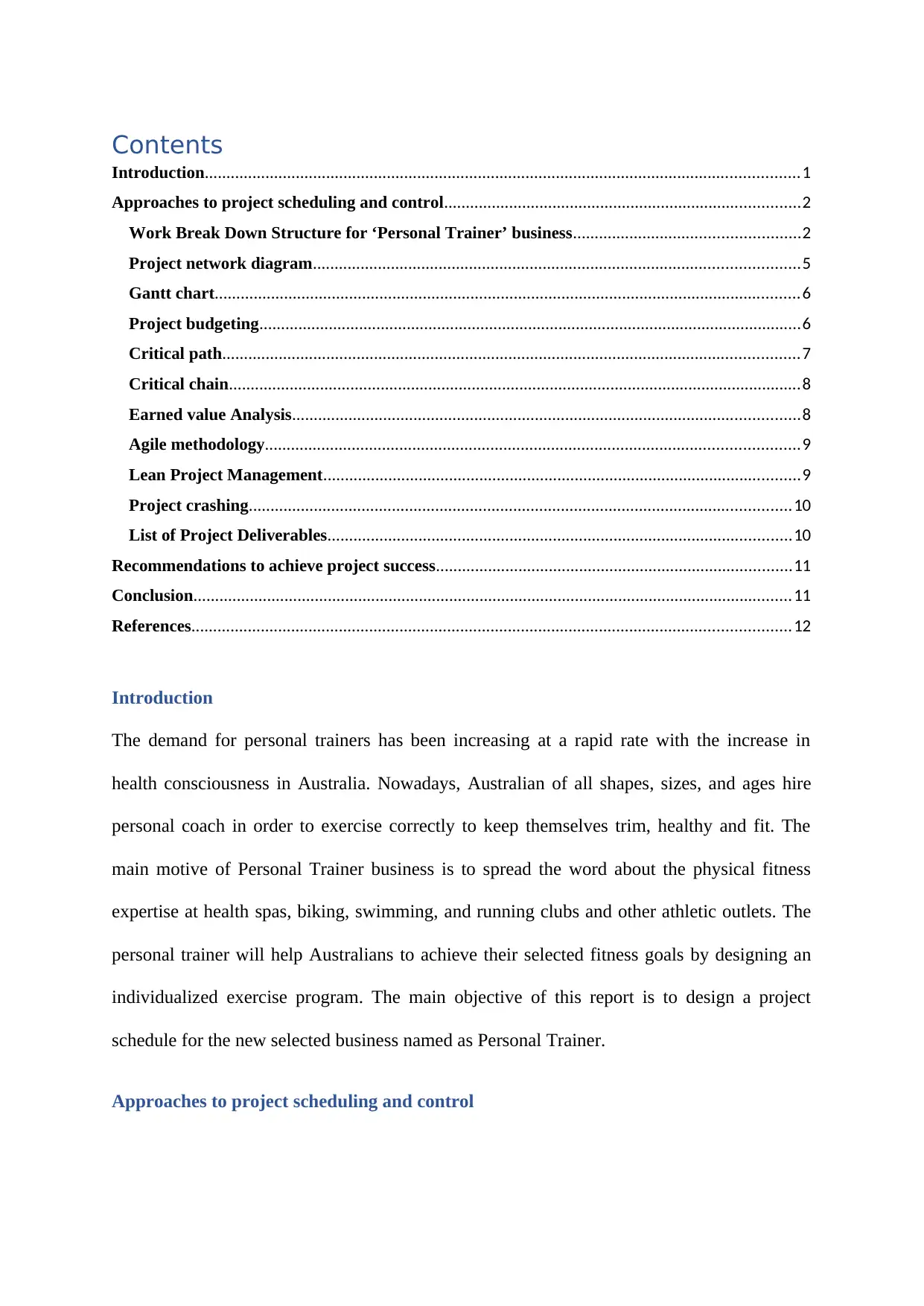
Contents
Introduction.........................................................................................................................................1
Approaches to project scheduling and control..................................................................................2
Work Break Down Structure for ‘Personal Trainer’ business....................................................2
Project network diagram................................................................................................................5
Gantt chart.......................................................................................................................................6
Project budgeting.............................................................................................................................6
Critical path.....................................................................................................................................7
Critical chain....................................................................................................................................8
Earned value Analysis.....................................................................................................................8
Agile methodology...........................................................................................................................9
Lean Project Management..............................................................................................................9
Project crashing.............................................................................................................................10
List of Project Deliverables...........................................................................................................10
Recommendations to achieve project success..................................................................................11
Conclusion..........................................................................................................................................11
References..........................................................................................................................................12
Introduction
The demand for personal trainers has been increasing at a rapid rate with the increase in
health consciousness in Australia. Nowadays, Australian of all shapes, sizes, and ages hire
personal coach in order to exercise correctly to keep themselves trim, healthy and fit. The
main motive of Personal Trainer business is to spread the word about the physical fitness
expertise at health spas, biking, swimming, and running clubs and other athletic outlets. The
personal trainer will help Australians to achieve their selected fitness goals by designing an
individualized exercise program. The main objective of this report is to design a project
schedule for the new selected business named as Personal Trainer.
Approaches to project scheduling and control
Introduction.........................................................................................................................................1
Approaches to project scheduling and control..................................................................................2
Work Break Down Structure for ‘Personal Trainer’ business....................................................2
Project network diagram................................................................................................................5
Gantt chart.......................................................................................................................................6
Project budgeting.............................................................................................................................6
Critical path.....................................................................................................................................7
Critical chain....................................................................................................................................8
Earned value Analysis.....................................................................................................................8
Agile methodology...........................................................................................................................9
Lean Project Management..............................................................................................................9
Project crashing.............................................................................................................................10
List of Project Deliverables...........................................................................................................10
Recommendations to achieve project success..................................................................................11
Conclusion..........................................................................................................................................11
References..........................................................................................................................................12
Introduction
The demand for personal trainers has been increasing at a rapid rate with the increase in
health consciousness in Australia. Nowadays, Australian of all shapes, sizes, and ages hire
personal coach in order to exercise correctly to keep themselves trim, healthy and fit. The
main motive of Personal Trainer business is to spread the word about the physical fitness
expertise at health spas, biking, swimming, and running clubs and other athletic outlets. The
personal trainer will help Australians to achieve their selected fitness goals by designing an
individualized exercise program. The main objective of this report is to design a project
schedule for the new selected business named as Personal Trainer.
Approaches to project scheduling and control
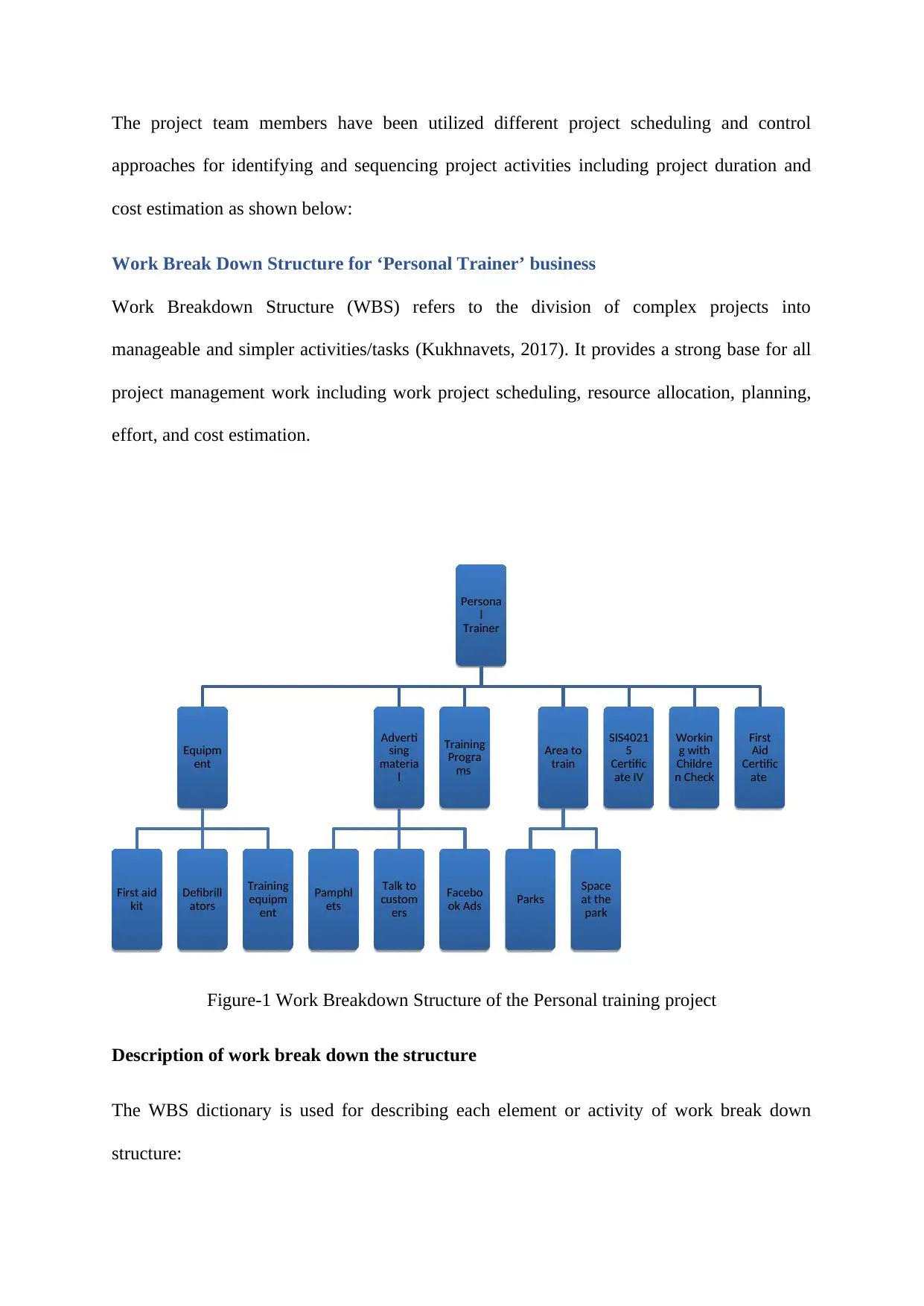
The project team members have been utilized different project scheduling and control
approaches for identifying and sequencing project activities including project duration and
cost estimation as shown below:
Work Break Down Structure for ‘Personal Trainer’ business
Work Breakdown Structure (WBS) refers to the division of complex projects into
manageable and simpler activities/tasks (Kukhnavets, 2017). It provides a strong base for all
project management work including work project scheduling, resource allocation, planning,
effort, and cost estimation.
Figure-1 Work Breakdown Structure of the Personal training project
Description of work break down the structure
The WBS dictionary is used for describing each element or activity of work break down
structure:
Persona
l
Trainer
Equipm
ent
First aid
kit
Defibrill
ators
Training
equipm
ent
Adverti
sing
materia
l
Pamphl
ets
Talk to
custom
ers
Facebo
ok Ads
Training
Progra
ms
Area to
train
Parks
Space
at the
park
SIS4021
5
Certific
ate IV
Workin
g with
Childre
n Check
First
Aid
Certific
ate
approaches for identifying and sequencing project activities including project duration and
cost estimation as shown below:
Work Break Down Structure for ‘Personal Trainer’ business
Work Breakdown Structure (WBS) refers to the division of complex projects into
manageable and simpler activities/tasks (Kukhnavets, 2017). It provides a strong base for all
project management work including work project scheduling, resource allocation, planning,
effort, and cost estimation.
Figure-1 Work Breakdown Structure of the Personal training project
Description of work break down the structure
The WBS dictionary is used for describing each element or activity of work break down
structure:
Persona
l
Trainer
Equipm
ent
First aid
kit
Defibrill
ators
Training
equipm
ent
Adverti
sing
materia
l
Pamphl
ets
Talk to
custom
ers
Facebo
ok Ads
Training
Progra
ms
Area to
train
Parks
Space
at the
park
SIS4021
5
Certific
ate IV
Workin
g with
Childre
n Check
First
Aid
Certific
ate
⊘ This is a preview!⊘
Do you want full access?
Subscribe today to unlock all pages.

Trusted by 1+ million students worldwide
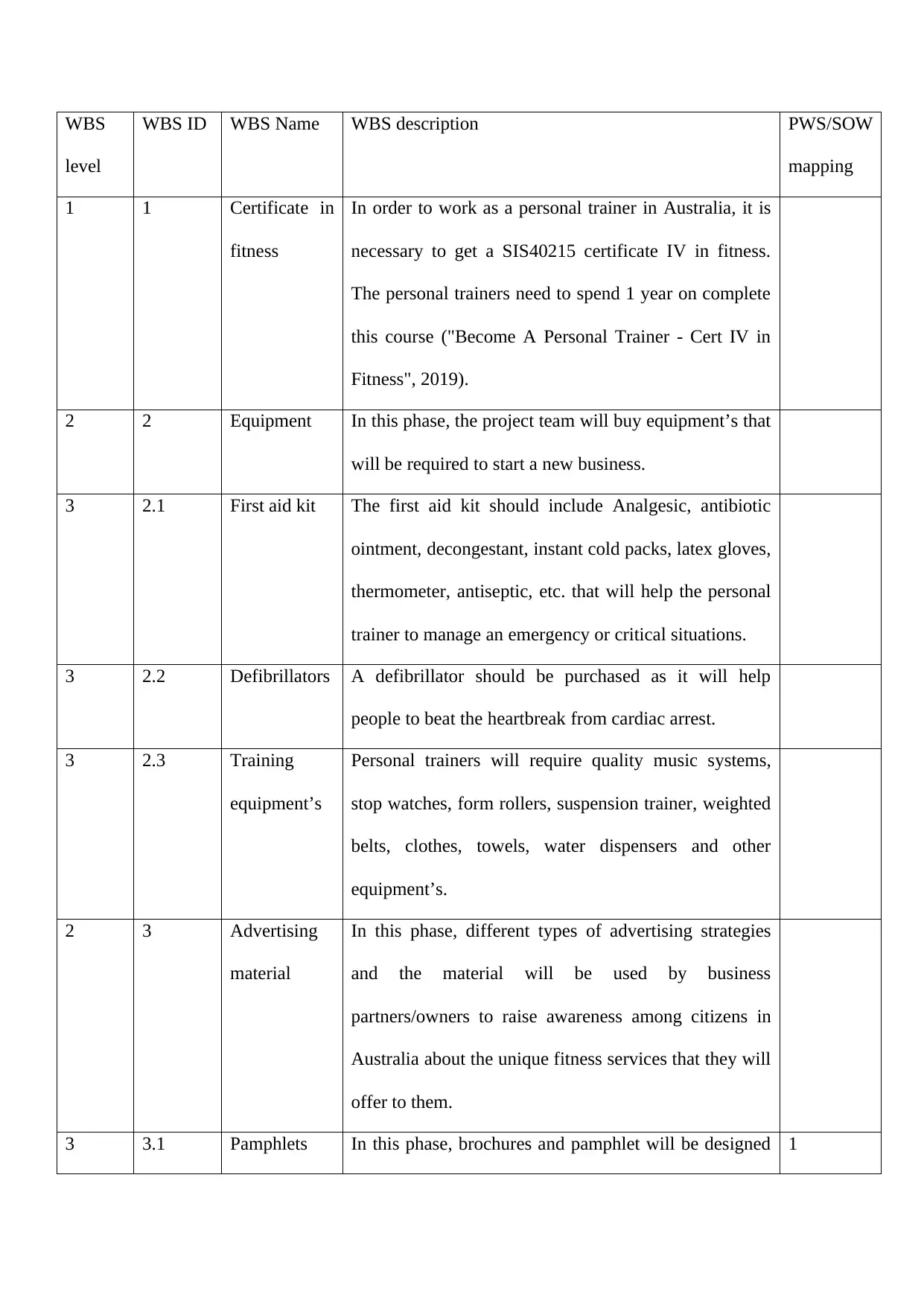
WBS
level
WBS ID WBS Name WBS description PWS/SOW
mapping
1 1 Certificate in
fitness
In order to work as a personal trainer in Australia, it is
necessary to get a SIS40215 certificate IV in fitness.
The personal trainers need to spend 1 year on complete
this course ("Become A Personal Trainer - Cert IV in
Fitness", 2019).
2 2 Equipment In this phase, the project team will buy equipment’s that
will be required to start a new business.
3 2.1 First aid kit The first aid kit should include Analgesic, antibiotic
ointment, decongestant, instant cold packs, latex gloves,
thermometer, antiseptic, etc. that will help the personal
trainer to manage an emergency or critical situations.
3 2.2 Defibrillators A defibrillator should be purchased as it will help
people to beat the heartbreak from cardiac arrest.
3 2.3 Training
equipment’s
Personal trainers will require quality music systems,
stop watches, form rollers, suspension trainer, weighted
belts, clothes, towels, water dispensers and other
equipment’s.
2 3 Advertising
material
In this phase, different types of advertising strategies
and the material will be used by business
partners/owners to raise awareness among citizens in
Australia about the unique fitness services that they will
offer to them.
3 3.1 Pamphlets In this phase, brochures and pamphlet will be designed 1
level
WBS ID WBS Name WBS description PWS/SOW
mapping
1 1 Certificate in
fitness
In order to work as a personal trainer in Australia, it is
necessary to get a SIS40215 certificate IV in fitness.
The personal trainers need to spend 1 year on complete
this course ("Become A Personal Trainer - Cert IV in
Fitness", 2019).
2 2 Equipment In this phase, the project team will buy equipment’s that
will be required to start a new business.
3 2.1 First aid kit The first aid kit should include Analgesic, antibiotic
ointment, decongestant, instant cold packs, latex gloves,
thermometer, antiseptic, etc. that will help the personal
trainer to manage an emergency or critical situations.
3 2.2 Defibrillators A defibrillator should be purchased as it will help
people to beat the heartbreak from cardiac arrest.
3 2.3 Training
equipment’s
Personal trainers will require quality music systems,
stop watches, form rollers, suspension trainer, weighted
belts, clothes, towels, water dispensers and other
equipment’s.
2 3 Advertising
material
In this phase, different types of advertising strategies
and the material will be used by business
partners/owners to raise awareness among citizens in
Australia about the unique fitness services that they will
offer to them.
3 3.1 Pamphlets In this phase, brochures and pamphlet will be designed 1
Paraphrase This Document
Need a fresh take? Get an instant paraphrase of this document with our AI Paraphraser
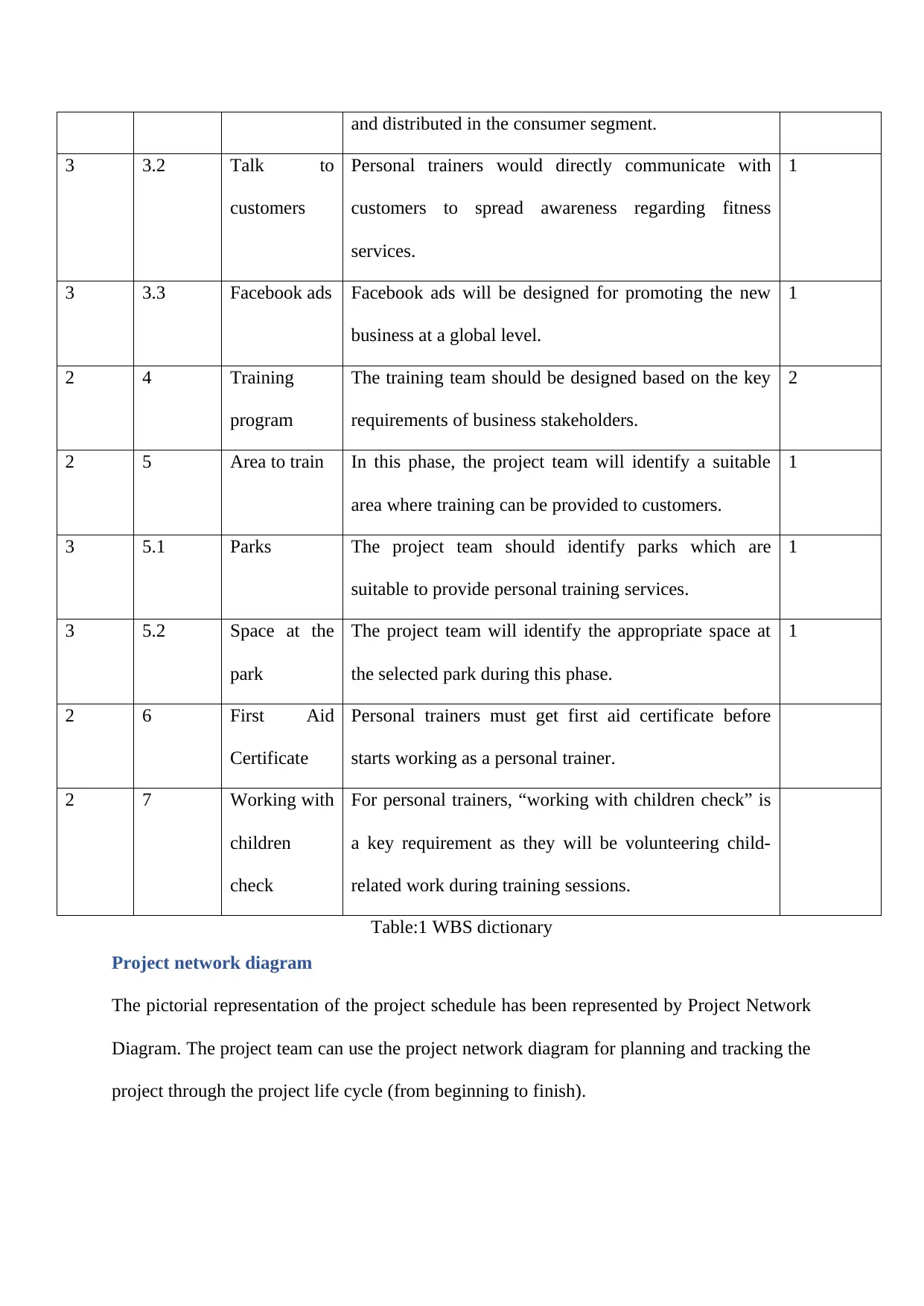
and distributed in the consumer segment.
3 3.2 Talk to
customers
Personal trainers would directly communicate with
customers to spread awareness regarding fitness
services.
1
3 3.3 Facebook ads Facebook ads will be designed for promoting the new
business at a global level.
1
2 4 Training
program
The training team should be designed based on the key
requirements of business stakeholders.
2
2 5 Area to train In this phase, the project team will identify a suitable
area where training can be provided to customers.
1
3 5.1 Parks The project team should identify parks which are
suitable to provide personal training services.
1
3 5.2 Space at the
park
The project team will identify the appropriate space at
the selected park during this phase.
1
2 6 First Aid
Certificate
Personal trainers must get first aid certificate before
starts working as a personal trainer.
2 7 Working with
children
check
For personal trainers, “working with children check” is
a key requirement as they will be volunteering child-
related work during training sessions.
Table:1 WBS dictionary
Project network diagram
The pictorial representation of the project schedule has been represented by Project Network
Diagram. The project team can use the project network diagram for planning and tracking the
project through the project life cycle (from beginning to finish).
3 3.2 Talk to
customers
Personal trainers would directly communicate with
customers to spread awareness regarding fitness
services.
1
3 3.3 Facebook ads Facebook ads will be designed for promoting the new
business at a global level.
1
2 4 Training
program
The training team should be designed based on the key
requirements of business stakeholders.
2
2 5 Area to train In this phase, the project team will identify a suitable
area where training can be provided to customers.
1
3 5.1 Parks The project team should identify parks which are
suitable to provide personal training services.
1
3 5.2 Space at the
park
The project team will identify the appropriate space at
the selected park during this phase.
1
2 6 First Aid
Certificate
Personal trainers must get first aid certificate before
starts working as a personal trainer.
2 7 Working with
children
check
For personal trainers, “working with children check” is
a key requirement as they will be volunteering child-
related work during training sessions.
Table:1 WBS dictionary
Project network diagram
The pictorial representation of the project schedule has been represented by Project Network
Diagram. The project team can use the project network diagram for planning and tracking the
project through the project life cycle (from beginning to finish).
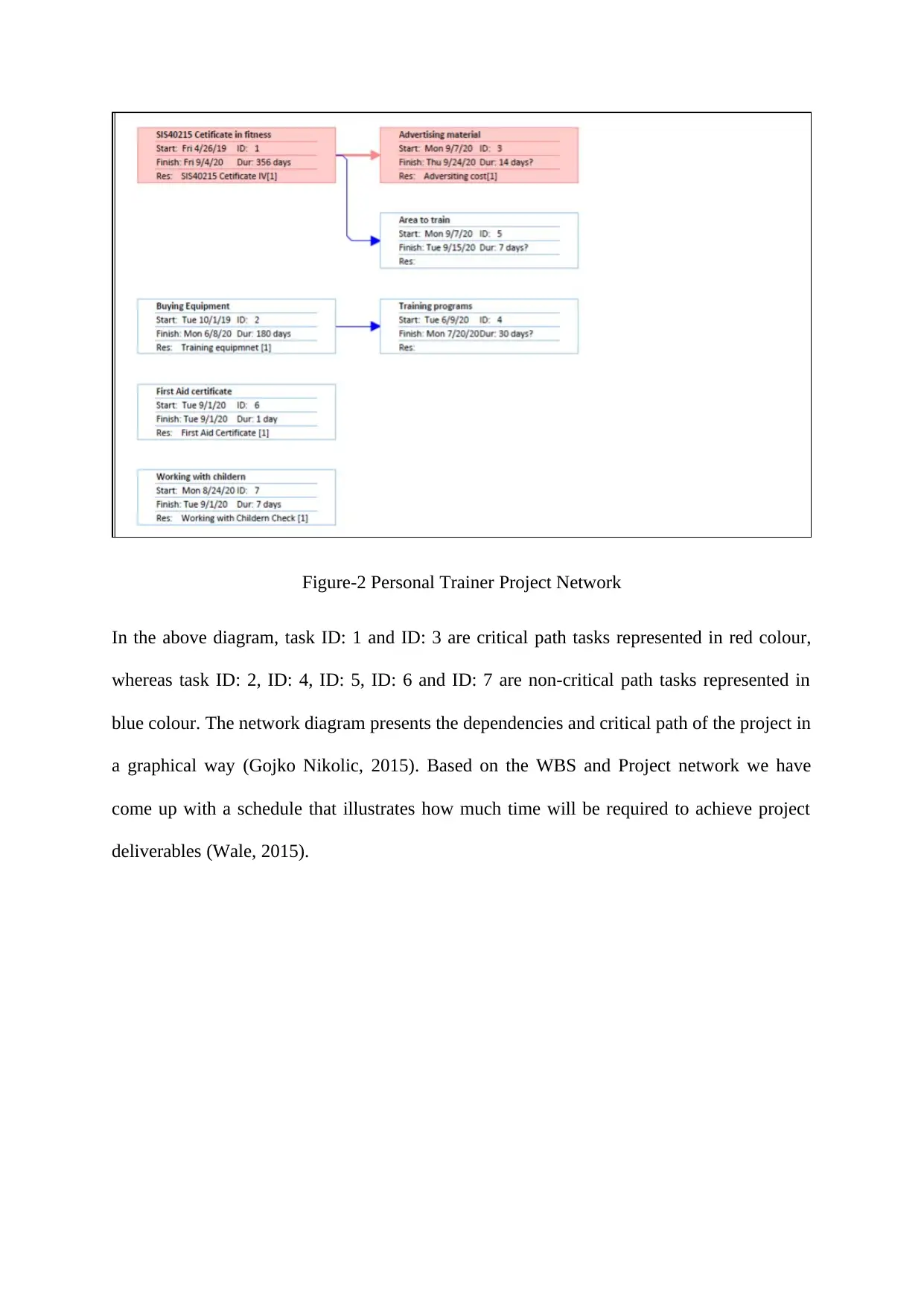
Figure-2 Personal Trainer Project Network
In the above diagram, task ID: 1 and ID: 3 are critical path tasks represented in red colour,
whereas task ID: 2, ID: 4, ID: 5, ID: 6 and ID: 7 are non-critical path tasks represented in
blue colour. The network diagram presents the dependencies and critical path of the project in
a graphical way (Gojko Nikolic, 2015). Based on the WBS and Project network we have
come up with a schedule that illustrates how much time will be required to achieve project
deliverables (Wale, 2015).
In the above diagram, task ID: 1 and ID: 3 are critical path tasks represented in red colour,
whereas task ID: 2, ID: 4, ID: 5, ID: 6 and ID: 7 are non-critical path tasks represented in
blue colour. The network diagram presents the dependencies and critical path of the project in
a graphical way (Gojko Nikolic, 2015). Based on the WBS and Project network we have
come up with a schedule that illustrates how much time will be required to achieve project
deliverables (Wale, 2015).
⊘ This is a preview!⊘
Do you want full access?
Subscribe today to unlock all pages.

Trusted by 1+ million students worldwide
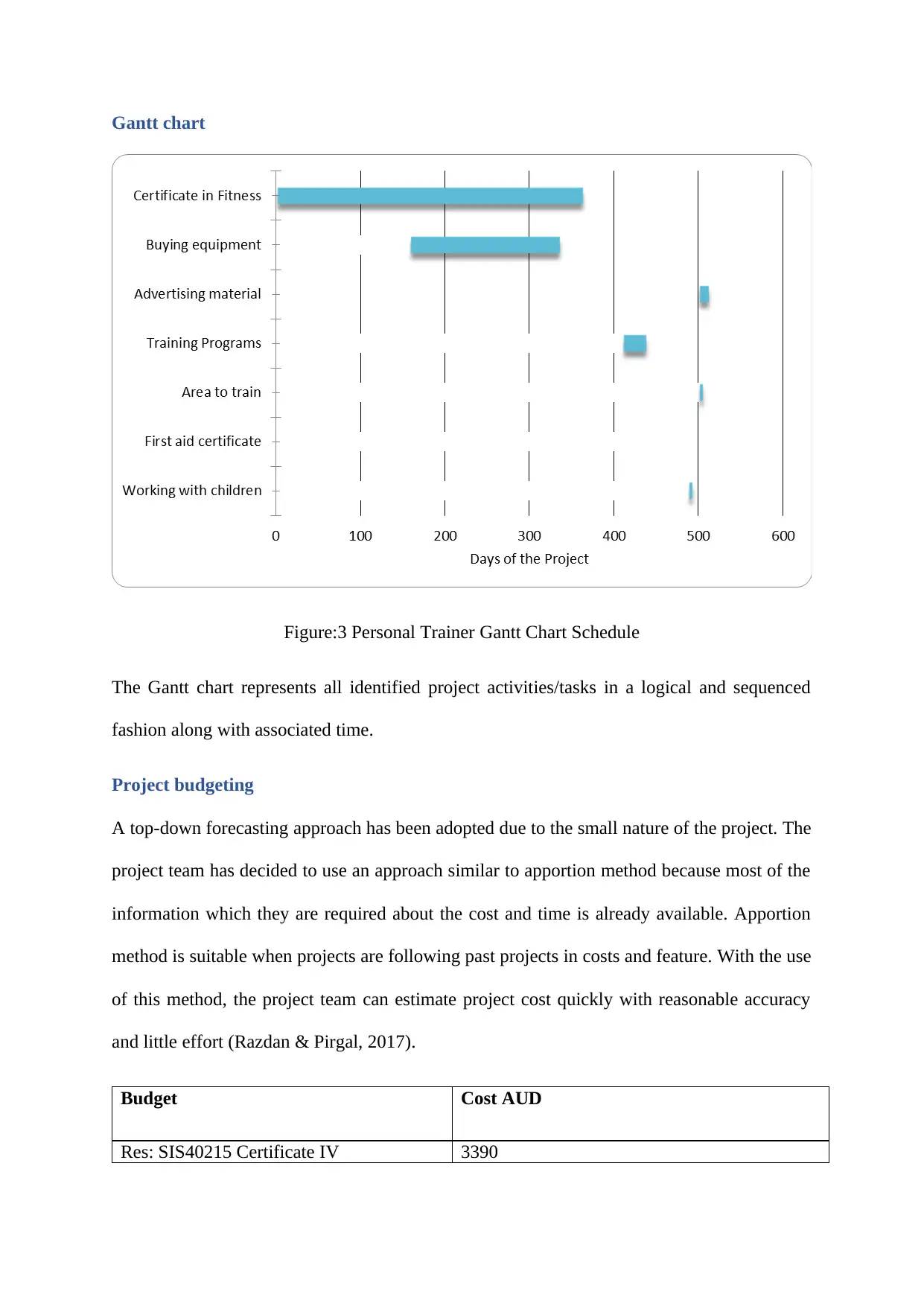
Gantt chart
Figure:3 Personal Trainer Gantt Chart Schedule
The Gantt chart represents all identified project activities/tasks in a logical and sequenced
fashion along with associated time.
Project budgeting
A top-down forecasting approach has been adopted due to the small nature of the project. The
project team has decided to use an approach similar to apportion method because most of the
information which they are required about the cost and time is already available. Apportion
method is suitable when projects are following past projects in costs and feature. With the use
of this method, the project team can estimate project cost quickly with reasonable accuracy
and little effort (Razdan & Pirgal, 2017).
Budget Cost AUD
Res: SIS40215 Certificate IV 3390
Figure:3 Personal Trainer Gantt Chart Schedule
The Gantt chart represents all identified project activities/tasks in a logical and sequenced
fashion along with associated time.
Project budgeting
A top-down forecasting approach has been adopted due to the small nature of the project. The
project team has decided to use an approach similar to apportion method because most of the
information which they are required about the cost and time is already available. Apportion
method is suitable when projects are following past projects in costs and feature. With the use
of this method, the project team can estimate project cost quickly with reasonable accuracy
and little effort (Razdan & Pirgal, 2017).
Budget Cost AUD
Res: SIS40215 Certificate IV 3390
Paraphrase This Document
Need a fresh take? Get an instant paraphrase of this document with our AI Paraphraser
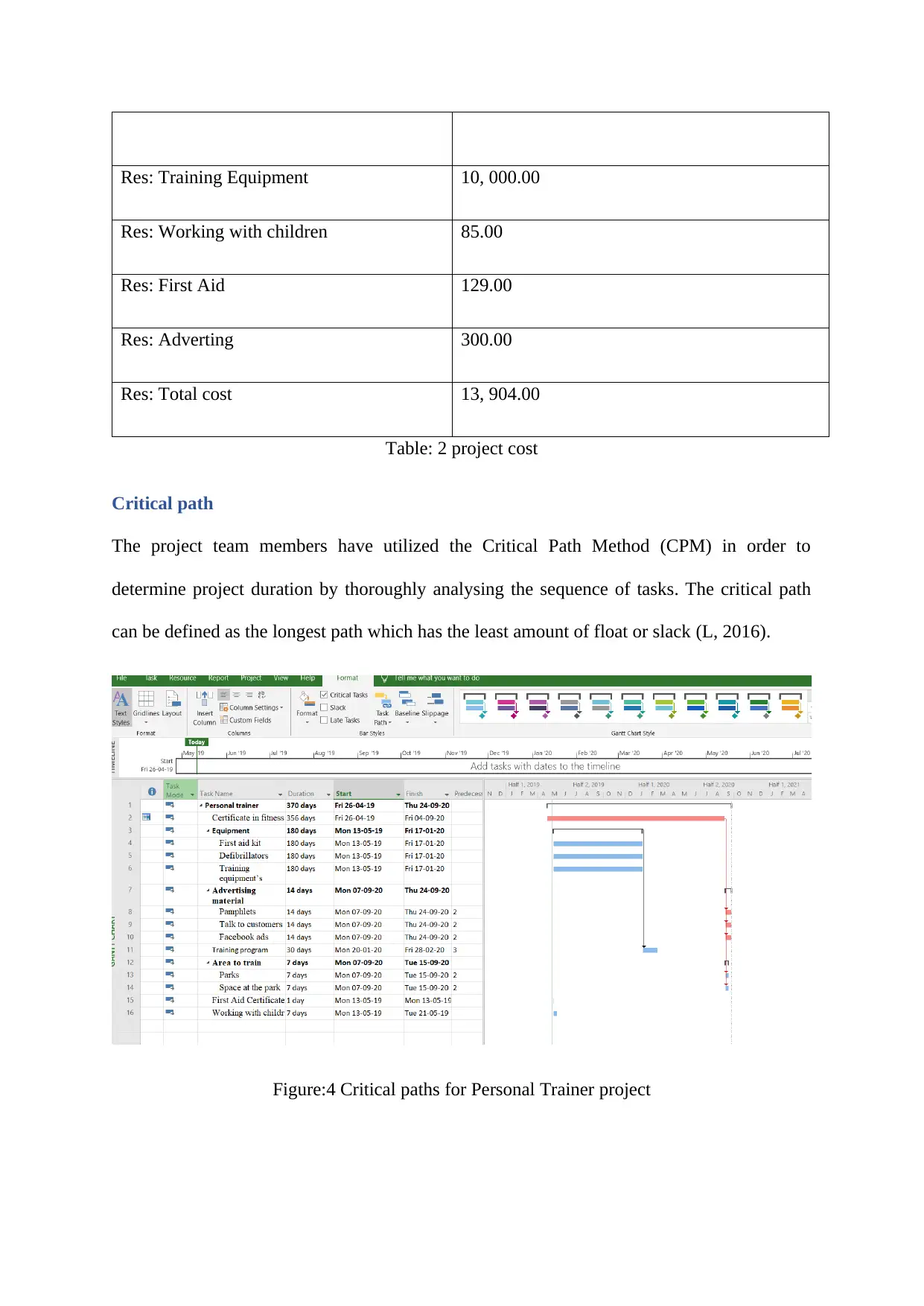
Res: Training Equipment 10, 000.00
Res: Working with children 85.00
Res: First Aid 129.00
Res: Adverting 300.00
Res: Total cost 13, 904.00
Table: 2 project cost
Critical path
The project team members have utilized the Critical Path Method (CPM) in order to
determine project duration by thoroughly analysing the sequence of tasks. The critical path
can be defined as the longest path which has the least amount of float or slack (L, 2016).
Figure:4 Critical paths for Personal Trainer project
Res: Working with children 85.00
Res: First Aid 129.00
Res: Adverting 300.00
Res: Total cost 13, 904.00
Table: 2 project cost
Critical path
The project team members have utilized the Critical Path Method (CPM) in order to
determine project duration by thoroughly analysing the sequence of tasks. The critical path
can be defined as the longest path which has the least amount of float or slack (L, 2016).
Figure:4 Critical paths for Personal Trainer project
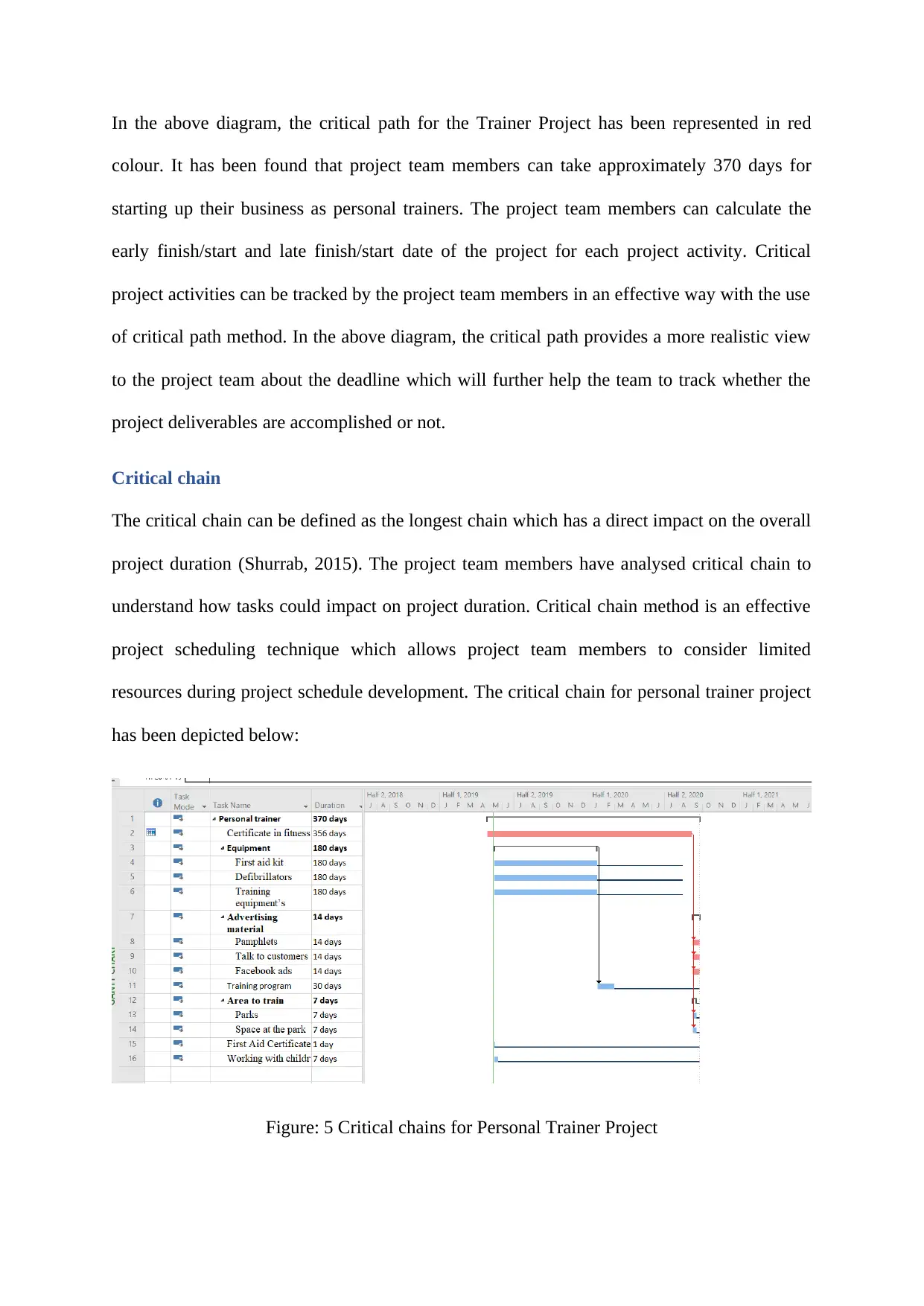
In the above diagram, the critical path for the Trainer Project has been represented in red
colour. It has been found that project team members can take approximately 370 days for
starting up their business as personal trainers. The project team members can calculate the
early finish/start and late finish/start date of the project for each project activity. Critical
project activities can be tracked by the project team members in an effective way with the use
of critical path method. In the above diagram, the critical path provides a more realistic view
to the project team about the deadline which will further help the team to track whether the
project deliverables are accomplished or not.
Critical chain
The critical chain can be defined as the longest chain which has a direct impact on the overall
project duration (Shurrab, 2015). The project team members have analysed critical chain to
understand how tasks could impact on project duration. Critical chain method is an effective
project scheduling technique which allows project team members to consider limited
resources during project schedule development. The critical chain for personal trainer project
has been depicted below:
Figure: 5 Critical chains for Personal Trainer Project
colour. It has been found that project team members can take approximately 370 days for
starting up their business as personal trainers. The project team members can calculate the
early finish/start and late finish/start date of the project for each project activity. Critical
project activities can be tracked by the project team members in an effective way with the use
of critical path method. In the above diagram, the critical path provides a more realistic view
to the project team about the deadline which will further help the team to track whether the
project deliverables are accomplished or not.
Critical chain
The critical chain can be defined as the longest chain which has a direct impact on the overall
project duration (Shurrab, 2015). The project team members have analysed critical chain to
understand how tasks could impact on project duration. Critical chain method is an effective
project scheduling technique which allows project team members to consider limited
resources during project schedule development. The critical chain for personal trainer project
has been depicted below:
Figure: 5 Critical chains for Personal Trainer Project
⊘ This is a preview!⊘
Do you want full access?
Subscribe today to unlock all pages.

Trusted by 1+ million students worldwide
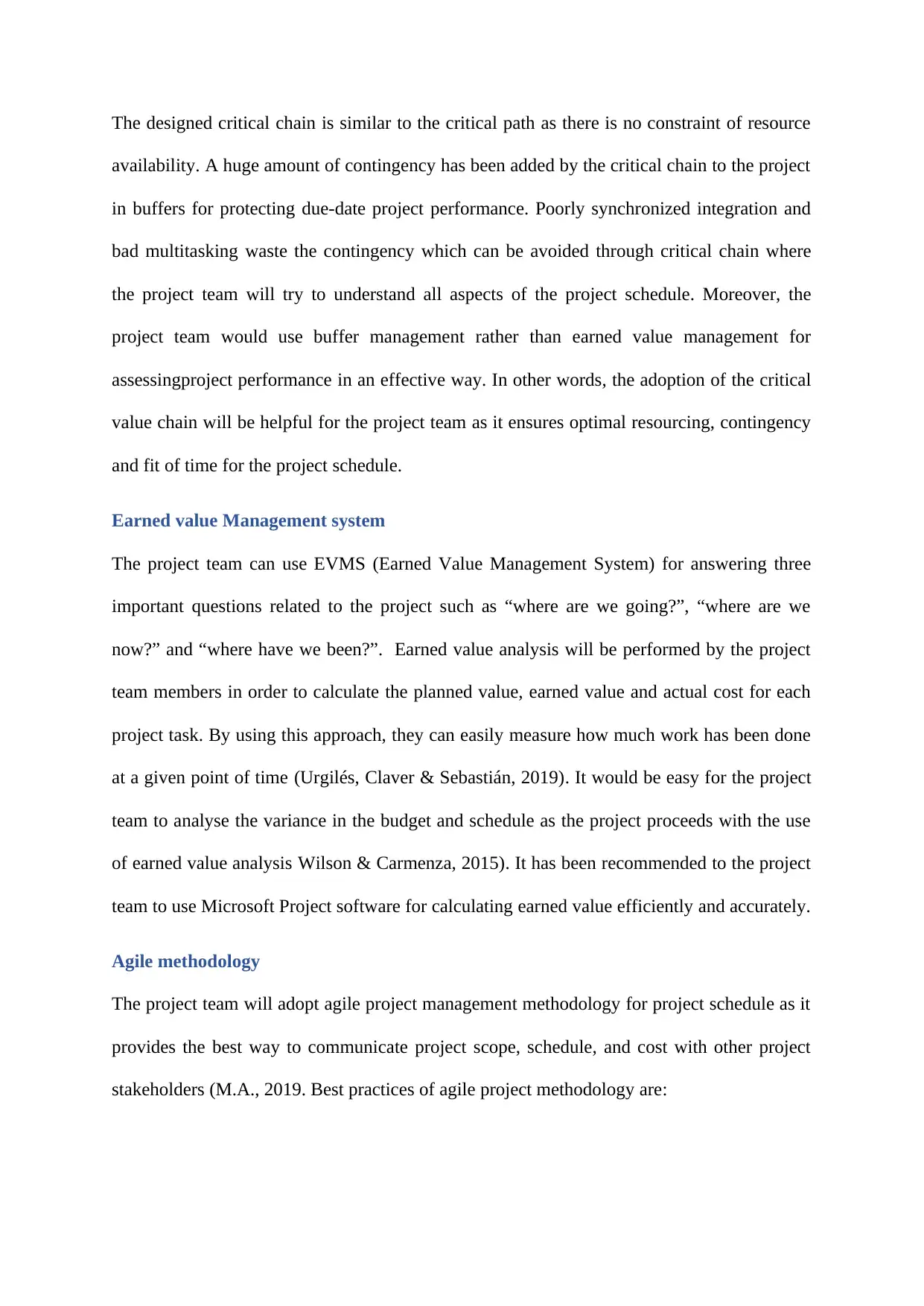
The designed critical chain is similar to the critical path as there is no constraint of resource
availability. A huge amount of contingency has been added by the critical chain to the project
in buffers for protecting due-date project performance. Poorly synchronized integration and
bad multitasking waste the contingency which can be avoided through critical chain where
the project team will try to understand all aspects of the project schedule. Moreover, the
project team would use buffer management rather than earned value management for
assessingproject performance in an effective way. In other words, the adoption of the critical
value chain will be helpful for the project team as it ensures optimal resourcing, contingency
and fit of time for the project schedule.
Earned value Management system
The project team can use EVMS (Earned Value Management System) for answering three
important questions related to the project such as “where are we going?”, “where are we
now?” and “where have we been?”. Earned value analysis will be performed by the project
team members in order to calculate the planned value, earned value and actual cost for each
project task. By using this approach, they can easily measure how much work has been done
at a given point of time (Urgilés, Claver & Sebastián, 2019). It would be easy for the project
team to analyse the variance in the budget and schedule as the project proceeds with the use
of earned value analysis Wilson & Carmenza, 2015). It has been recommended to the project
team to use Microsoft Project software for calculating earned value efficiently and accurately.
Agile methodology
The project team will adopt agile project management methodology for project schedule as it
provides the best way to communicate project scope, schedule, and cost with other project
stakeholders (M.A., 2019. Best practices of agile project methodology are:
availability. A huge amount of contingency has been added by the critical chain to the project
in buffers for protecting due-date project performance. Poorly synchronized integration and
bad multitasking waste the contingency which can be avoided through critical chain where
the project team will try to understand all aspects of the project schedule. Moreover, the
project team would use buffer management rather than earned value management for
assessingproject performance in an effective way. In other words, the adoption of the critical
value chain will be helpful for the project team as it ensures optimal resourcing, contingency
and fit of time for the project schedule.
Earned value Management system
The project team can use EVMS (Earned Value Management System) for answering three
important questions related to the project such as “where are we going?”, “where are we
now?” and “where have we been?”. Earned value analysis will be performed by the project
team members in order to calculate the planned value, earned value and actual cost for each
project task. By using this approach, they can easily measure how much work has been done
at a given point of time (Urgilés, Claver & Sebastián, 2019). It would be easy for the project
team to analyse the variance in the budget and schedule as the project proceeds with the use
of earned value analysis Wilson & Carmenza, 2015). It has been recommended to the project
team to use Microsoft Project software for calculating earned value efficiently and accurately.
Agile methodology
The project team will adopt agile project management methodology for project schedule as it
provides the best way to communicate project scope, schedule, and cost with other project
stakeholders (M.A., 2019. Best practices of agile project methodology are:
Paraphrase This Document
Need a fresh take? Get an instant paraphrase of this document with our AI Paraphraser
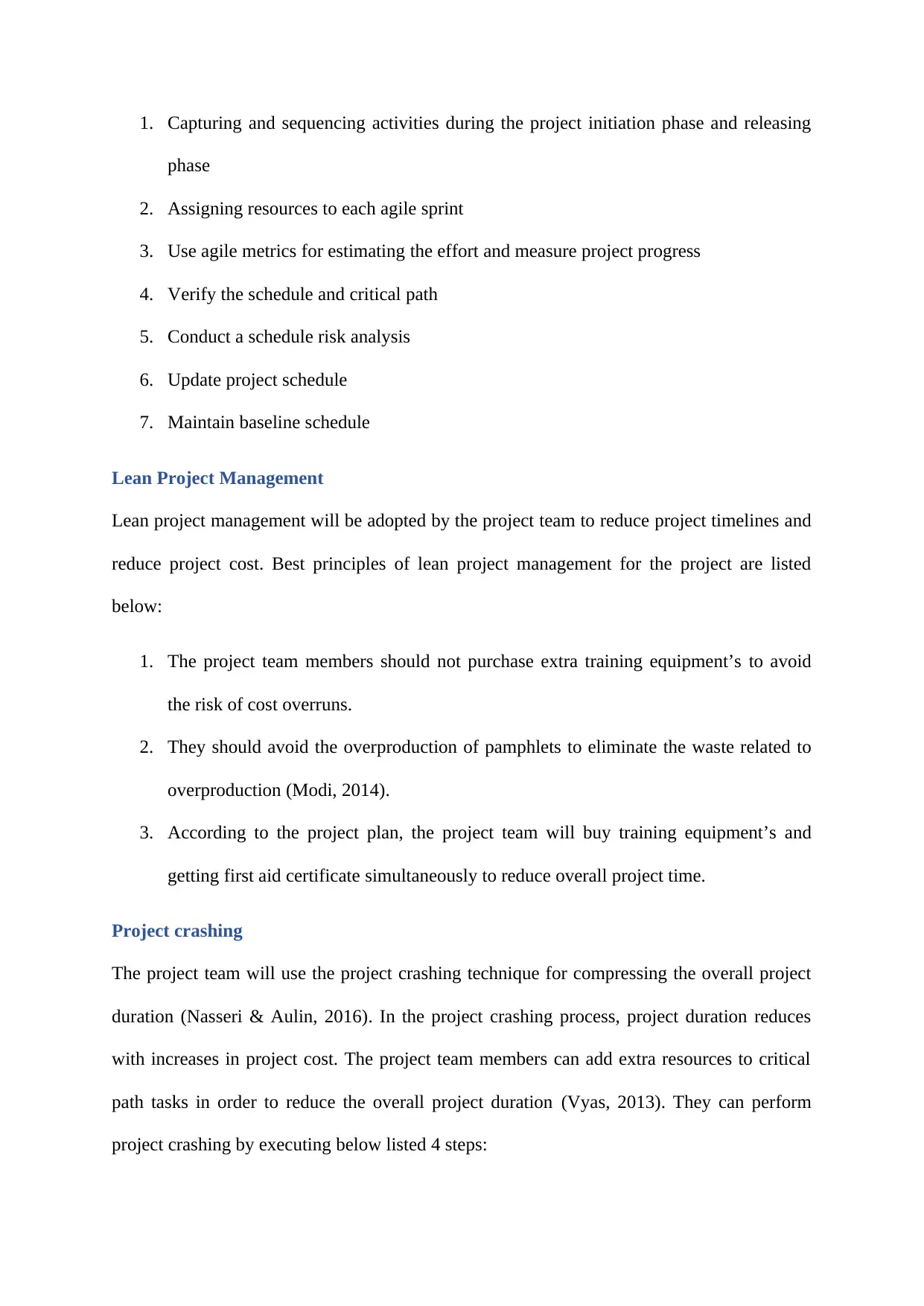
1. Capturing and sequencing activities during the project initiation phase and releasing
phase
2. Assigning resources to each agile sprint
3. Use agile metrics for estimating the effort and measure project progress
4. Verify the schedule and critical path
5. Conduct a schedule risk analysis
6. Update project schedule
7. Maintain baseline schedule
Lean Project Management
Lean project management will be adopted by the project team to reduce project timelines and
reduce project cost. Best principles of lean project management for the project are listed
below:
1. The project team members should not purchase extra training equipment’s to avoid
the risk of cost overruns.
2. They should avoid the overproduction of pamphlets to eliminate the waste related to
overproduction (Modi, 2014).
3. According to the project plan, the project team will buy training equipment’s and
getting first aid certificate simultaneously to reduce overall project time.
Project crashing
The project team will use the project crashing technique for compressing the overall project
duration (Nasseri & Aulin, 2016). In the project crashing process, project duration reduces
with increases in project cost. The project team members can add extra resources to critical
path tasks in order to reduce the overall project duration (Vyas, 2013). They can perform
project crashing by executing below listed 4 steps:
phase
2. Assigning resources to each agile sprint
3. Use agile metrics for estimating the effort and measure project progress
4. Verify the schedule and critical path
5. Conduct a schedule risk analysis
6. Update project schedule
7. Maintain baseline schedule
Lean Project Management
Lean project management will be adopted by the project team to reduce project timelines and
reduce project cost. Best principles of lean project management for the project are listed
below:
1. The project team members should not purchase extra training equipment’s to avoid
the risk of cost overruns.
2. They should avoid the overproduction of pamphlets to eliminate the waste related to
overproduction (Modi, 2014).
3. According to the project plan, the project team will buy training equipment’s and
getting first aid certificate simultaneously to reduce overall project time.
Project crashing
The project team will use the project crashing technique for compressing the overall project
duration (Nasseri & Aulin, 2016). In the project crashing process, project duration reduces
with increases in project cost. The project team members can add extra resources to critical
path tasks in order to reduce the overall project duration (Vyas, 2013). They can perform
project crashing by executing below listed 4 steps:
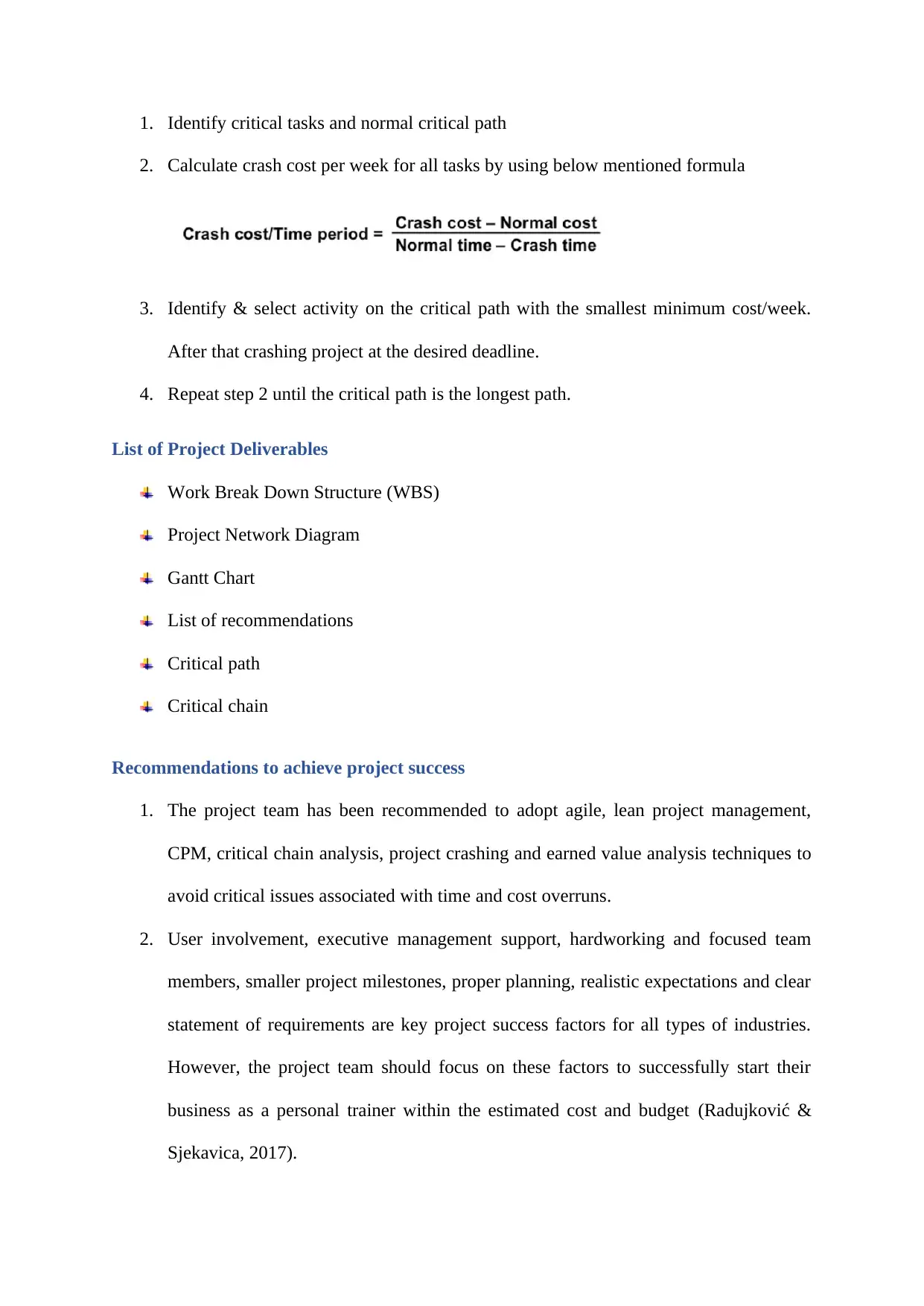
1. Identify critical tasks and normal critical path
2. Calculate crash cost per week for all tasks by using below mentioned formula
3. Identify & select activity on the critical path with the smallest minimum cost/week.
After that crashing project at the desired deadline.
4. Repeat step 2 until the critical path is the longest path.
List of Project Deliverables
Work Break Down Structure (WBS)
Project Network Diagram
Gantt Chart
List of recommendations
Critical path
Critical chain
Recommendations to achieve project success
1. The project team has been recommended to adopt agile, lean project management,
CPM, critical chain analysis, project crashing and earned value analysis techniques to
avoid critical issues associated with time and cost overruns.
2. User involvement, executive management support, hardworking and focused team
members, smaller project milestones, proper planning, realistic expectations and clear
statement of requirements are key project success factors for all types of industries.
However, the project team should focus on these factors to successfully start their
business as a personal trainer within the estimated cost and budget (Radujković &
Sjekavica, 2017).
2. Calculate crash cost per week for all tasks by using below mentioned formula
3. Identify & select activity on the critical path with the smallest minimum cost/week.
After that crashing project at the desired deadline.
4. Repeat step 2 until the critical path is the longest path.
List of Project Deliverables
Work Break Down Structure (WBS)
Project Network Diagram
Gantt Chart
List of recommendations
Critical path
Critical chain
Recommendations to achieve project success
1. The project team has been recommended to adopt agile, lean project management,
CPM, critical chain analysis, project crashing and earned value analysis techniques to
avoid critical issues associated with time and cost overruns.
2. User involvement, executive management support, hardworking and focused team
members, smaller project milestones, proper planning, realistic expectations and clear
statement of requirements are key project success factors for all types of industries.
However, the project team should focus on these factors to successfully start their
business as a personal trainer within the estimated cost and budget (Radujković &
Sjekavica, 2017).
⊘ This is a preview!⊘
Do you want full access?
Subscribe today to unlock all pages.

Trusted by 1+ million students worldwide
1 out of 14
Your All-in-One AI-Powered Toolkit for Academic Success.
+13062052269
info@desklib.com
Available 24*7 on WhatsApp / Email
![[object Object]](/_next/static/media/star-bottom.7253800d.svg)
Unlock your academic potential
Copyright © 2020–2025 A2Z Services. All Rights Reserved. Developed and managed by ZUCOL.
